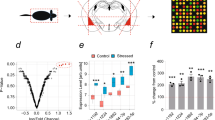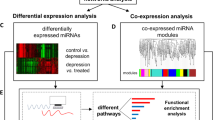Abstract
MicroRNAs are a class of non-coding RNAs with a growing relevance in the regulation of gene expression related to brain function and plasticity. They have the potential to orchestrate complex phenomena, such as the neuronal response to homeostatic challenges. We previously demonstrated the involvement of miR-135a in the regulation of early stress response. In the present study, we examine the role of miR-135a in stress-related behavior. We show that the knockdown (KD) of miR-135a in the mouse amygdala induces an increase in anxiety-like behavior. Consistently with behavioral studies, electrophysiological experiments in acute brain slices indicate an increase of amygdala spontaneous excitatory postsynaptic currents, as a result of miR-135a KD. Furthermore, we presented direct evidences, by in vitro assays and in vivo miRNA overexpression in the amygdala, that two key regulators of synaptic vesicle fusion, complexin-1 and complexin-2, are direct targets of miR-135a. In vitro analysis of miniature excitatory postsynaptic currents on miR-135a KD primary neurons indicates unpaired quantal excitatory neurotransmission. Finally, increased levels of complexin-1 and complexin-2 proteins were detected in the mouse amygdala after acute stress, accordingly to the previously observed stress-induced miR-135a downregulation. Overall, our results unravel a previously unknown miRNA-dependent mechanism in the amygdala for regulating anxiety-like behavior, providing evidences of a physiological role of miR-135a in the modulation of presynaptic mechanisms of glutamatergic neurotransmission.






Similar content being viewed by others
References
Bartel DP (2004) MicroRNAs: genomics, biogenesis, mechanism, and function. Cell 116:281–297
Krol J, Loedige I, Filipowicz W (2010) The widespread regulation of microRNA biogenesis, function and decay. Nat Rev Genet. doi:10.1038/nrg2843
Eichhorn SW, Guo H, McGeary SE et al (2014) mRNA destabilization is the dominant effect of mammalian MicroRNAs by the time substantial repression ensues. Mol Cell 56:104–115. doi:10.1016/j.molcel.2014.08.028
Kosik KS (2006) The neuronal microRNA system. Nat Rev Neurosci 7:911–920. doi:10.1038/nrn2037
Schratt G (2009) microRNAs at the synapse. Nat Rev Neurosci 10:842–849. doi:10.1038/nrn2763
Siegel G, Saba R, Schratt G (2011) microRNAs in neurons: manifold regulatory roles at the synapse. Curr Opin Genet Dev 21:491–497. doi:10.1016/j.gde.2011.04.008
van Spronsen M, van Battum EY, Kuijpers M et al (2013) Developmental and activity-dependent miRNA expression profiling in primary hippocampal neuron cultures. PLoS One 8:e74907. doi:10.1371/journal.pone.0074907.s002
Ashraf SI, McLoon AL, Sclarsic SM, Kunes S (2006) Synaptic protein synthesis associated with memory is regulated by the RISC pathway in Drosophila. Cell 124:191–205. doi:10.1016/j.cell.2005.12.017
Capitano F, Camon J, Ferretti V et al (2015) microRNAs modulate spatial memory in the hippocampus and in the ventral striatum in a region-specific manner. Mol Neurobiol. doi:10.1007/s12035-015-9398-5
Capitano F, Camon J, Licursi V et al (2016) MicroRNA-335-5p modulates spatial memory and hippocampal synaptic plasticity. Neurobiol Learn Mem 139:63–68. doi:10.1016/j.nlm.2016.12.019
Dias C, Feng J, Sun H, et al (2014) β-Catenin mediates stress resilience through Dicer1/microRNA regulation. Nature 1–17. doi:10.1038/nature13976
Dias BG, Goodman JV, Ahluwalia R et al (2014) Amygdala-dependent fear memory consolidation via miR-34a and notch signaling. Neuron 83:906–918. doi:10.1016/j.neuron.2014.07.019
Volk N, Paul ED, Haramati S et al (2014) MicroRNA-19b associates with Ago2 in the amygdala following chronic stress and regulates the adrenergic receptor beta 1. J Neurosci 34:15070–15082. doi:10.1523/JNEUROSCI.0855-14.2014
Issler O, Haramati S, Paul ED et al (2014) MicroRNA 135 is essential for chronic stress resiliency, antidepressant efficacy, and intact serotonergic activity. Neuron 83:344–360. doi:10.1016/j.neuron.2014.05.042
Mannironi C, Camon J, De Vito F et al (2013) Acute stress alters amygdala microRNA miR-135a and miR-124 expression: inferences for corticosteroid dependent stress response. PLoS One 8:e73385. doi:10.1371/journal.pone.0073385
Meerson A, Cacheaux L, Goosens KA et al (2010) Changes in brain MicroRNAs contribute to cholinergic stress reactions. J Mol Neurosci 40:47–55. doi:10.1007/s12031-009-9252-1
Rinaldi A, Vincenti S, De Vito F et al (2010) Behav Brain Res 208:265–269. doi:10.1016/j.bbr.2009.11.012
Malan-Müller S, Hemmings SMJ, Seedat S (2012) Big effects of small RNAs: a review of MicroRNAs in anxiety. Mol Neurobiol 47:726–739. doi:10.1007/s12035-012-8374-6
Roozendaal B, McEwen BS, Chattarji S (2009) Stress, memory and the amygdala. Nat Rev Neurosci 10:423–433. doi:10.1038/nrn2651
Davidson RJ, Abercrombie H, Nitschke JB, Putnam K (1999) Regional brain function, emotion and disorders of emotion. Curr Opin Neurobiol 9:228–234
Jiang L, Role LW (2008) Facilitation of cortico-amygdala synapses by nicotine: activity-dependent modulation of glutamatergic transmission. J Neurophysiol 99:1988–1999. doi:10.1152/jn.00933.2007
Haramati S, Navon I, Issler O et al (2011) microRNA as repressors of stress-induced anxiety: the case of amygdala miR-34. J Neurosci 31:14191–14203. doi:10.1523/JNEUROSCI.1673-11.2011
Vetere G, Barbato C, Pezzola S et al (2014) Selective inhibition of miR-92 in hippocampal neurons alters contextual fear memory. Hippocampus 24:1458–1465. doi:10.1002/hipo.22326
Sempere LF, Freemantle S, Pitha-Rowe I et al (2004) Expression profiling of mammalian microRNAs uncovers a subset of brain-expressed microRNAs with possible roles in murine and human neuronal differentiation. Genome Biol 5:1–11. doi:10.1186/gb-2004-5-3-r13
Li X, Khanna A, Li N, Wang E (2011) Circulatory miR-34a as an RNA-based, noninvasive biomarker for brain aging. Aging (Albany NY)
Elmén J, Lindow M, Schütz S et al (2008) LNA-mediated microRNA silencing in non-human primates. Nature 452:896–899. doi:10.1038/nature06783
Kocerha J, Faghihi MA, Lopez-Toledano MA et al (2009) MicroRNA-219 modulates NMDA receptor-mediated neurobehavioral dysfunction. Proc Natl Acad Sci 106:3507–3512. doi:10.1073/pnas.0805854106
Jimenez-Mateos EM, Bray I, Sanz-Rodriguez A et al (2011) miRNA expression profile after status epilepticus and hippocampal neuroprotection by targeting miR-132. Am J Pathol 179:2519–2532. doi:10.1016/j.ajpath.2011.07.036
Zovoilis A, Agbemenyah HY, Agis-Balboa RC et al (2011) microRNA-34c is a novel target to treat dementias. EMBO J 30:4299–4308. doi:10.1038/emboj.2011.327
Brose N (2008) For better or for worse: complexins regulate SNARE function and vesicle fusion. Traffic 9:1403–1413. doi:10.1111/j.1600-0854.2008.00758.x
Maximov A, Tang J, Yang X et al (2009) Complexin controls the force transfer from SNARE complexes to membranes in fusion. Science 323:516–521. doi:10.1126/science.1166505
Ahmad M, Polepalli JS, Goswami D et al (2012) Postsynaptic complexin controls AMPA receptor exocytosis during LTP. Neuron 73:260–267. doi:10.1016/j.neuron.2011.11.020
McMahon HT, Missler M, Li C, Sudhof TC (1995) Complexins: cytosolic proteins that regulate SNAP receptor function. Cell 83(1):111–119
Hu Z, Yu D, Gu Q et al (2014) miR-191 and miR-135 are required for long-lasting spine remodelling associated with synaptic long-term depression. Nat Comms. doi:10.1038/ncomms4263
Peña CJ, Bagot RC, Labonté B, Nestler EJ (2014) Epigenetic signaling in psychiatric disorders. J Mol Biol 426:3389–3412. doi:10.1016/j.jmb.2014.03.016
Tye KM, Prakash R, Kim S-Y et al (2011) Amygdala circuitry mediating reversible and bidirectional control of anxiety. Nature 471:358–362. doi:10.1038/nature09820
Ciocchi S, Herry C, Grenier F et al (2010) Encoding of conditioned fear in central amygdala inhibitory circuits. Nature 468:277–282. doi:10.1038/nature09559
Haubensak W, Kunwar PS, Cai H et al (2010) Genetic dissection of an amygdala microcircuit that gates conditioned fear. Nature 468:270–276. doi:10.1038/nature09553
Hubert GW, Li C, Rainnie DG, Muly EC (2013) Effects of stress on AMPA receptor distribution and function in the basolateral amygdala. Brain Struct Funct 219:1169–1179. doi:10.1007/s00429-013-0557-z
de Kloet ER, Joëls M, Holsboer F (2005) Stress and the brain: from adaptation to disease. Nat Rev Neurosci 6:463–475. doi:10.1038/nrn1683
Krugers HJ, Hoogenraad CC, Groc L (2010) Stress hormones and AMPA receptor trafficking in synaptic plasticity and memory. Nat Rev Neurosci 11:675–681. doi:10.1038/nrn2913
Zhou H, Guo W, Zhao Y et al (2014) MicroRNA-135a acts as a putative tumor suppressor by directly targeting very low density lipoprotein receptor in human gallbladder cancer. Cancer Sci 105:956–965. doi:10.1111/cas.12463
Kroiss A, Vincent S, Decaussin-Petrucci M et al (2015) Androgen-regulated microRNA-135a decreases prostate cancer cell migration and invasion through downregulating ROCK1 and ROCK2. Oncogene 34:2846–2855. doi:10.1038/onc.2014.222
Hemmesi K, Squadrito ML, Mestdagh P, Conti V, Cominelli M, Piras IS, Sergi LS, Piccinin S et al (2015) miR-135a inhibits cancer stem cell-driven medulloblastoma development by directly repressing Arhgef6 expression. Stem Cells 33:1377–1389. doi:10.1002/stem.1958
Chang S, Reim K, Pedersen M et al (2015) Complexin stabilizes newly primed synaptic vesicles and prevents their premature fusion at the mouse calyx of held synapse. J Neurosci 35:8272–8290. doi:10.1523/JNEUROSCI.4841-14.2015
Brose N (2008) Altered complexin expression in psychiatric and neurological disorders: cause or consequence? Mol Cells 25:7–19
Heegde ter F, De Rijk RH, Vinkers CH (2015) The brain mineralocorticoid receptor and stress resilience. Psychoneuroendocrinology 52:92–110. doi:10.1016/j.psyneuen.2014.10.022
Acknowledgements
We thank Bio-Fab Research for helpful technical support. This work was supported by Project F57I12000110009 Filas Grant to C.P., ERC-2013 (AdG 340172–MUNCODD) and AriSLA, and full grant 2014 “RNA circuitries in Amyotrophic Lateral Sclerosis pathogenesis” to I.B.
Author information
Authors and Affiliations
Corresponding author
Ethics declarations
All experiments were conducted in strict accordance to the European Community and Italian Nation regulation of animal use in research, and following NIH guidelines on animal care.
Electronic supplementary material
ESM 1
(PDF 68891 kb)
Rights and permissions
About this article
Cite this article
Mannironi, C., Biundo, A., Rajendran, S. et al. miR-135a Regulates Synaptic Transmission and Anxiety-Like Behavior in Amygdala. Mol Neurobiol 55, 3301–3315 (2018). https://doi.org/10.1007/s12035-017-0564-9
Received:
Accepted:
Published:
Issue Date:
DOI: https://doi.org/10.1007/s12035-017-0564-9




